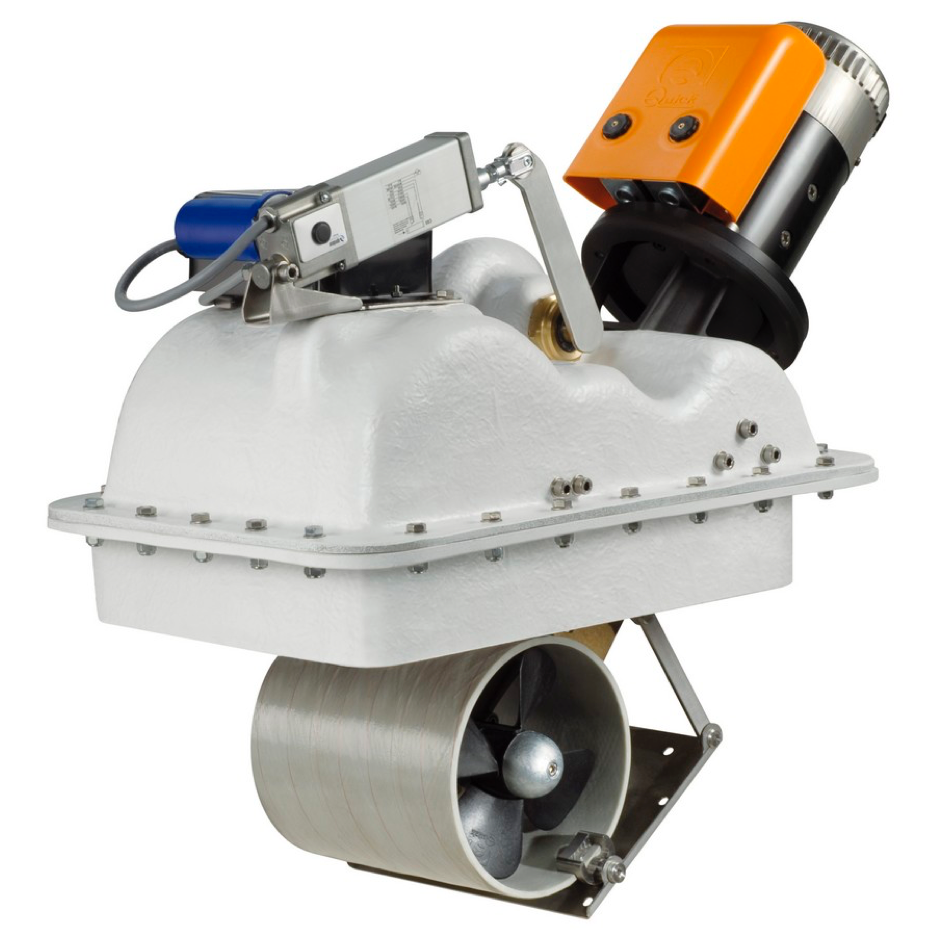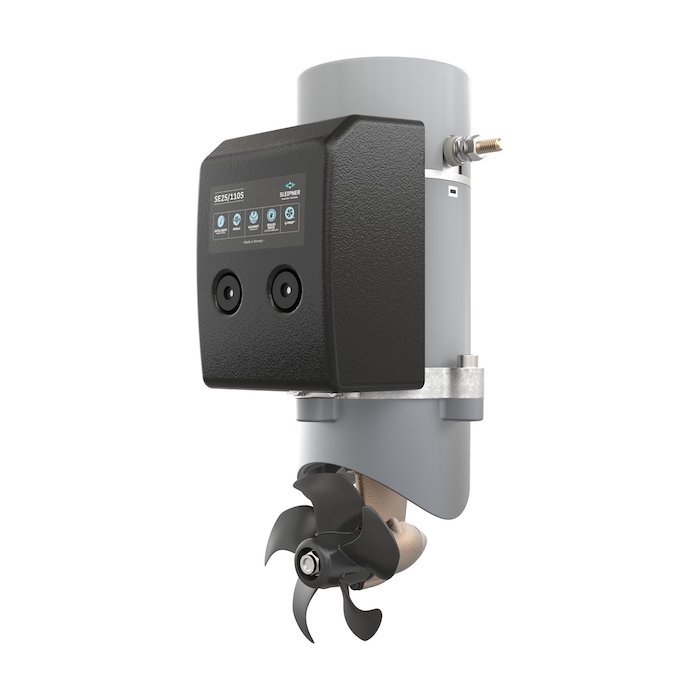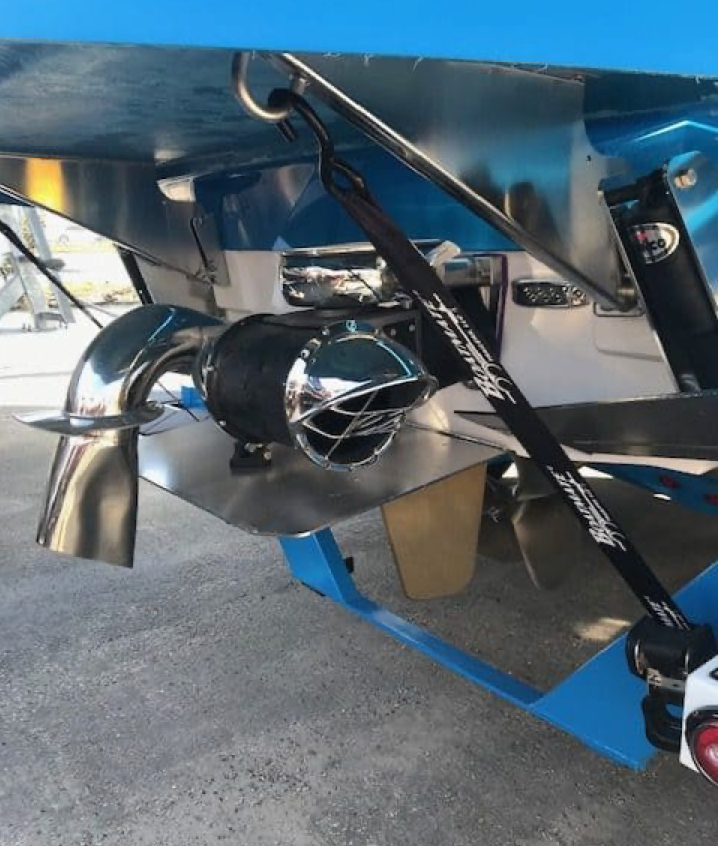Thrusters, Part II: Choosing the Right Fit

At some point in our boating history, all of us have felt a bit of trepidation when entering a crowded harbor and trying to fit a boat into a tight slip or a spot at the fuel dock. This is only exacerbated when there’s an obnoxious wind or current.
Thrusters are a cost-efficient way of dealing with these challenges, even in this era of joystick docking with the main engines. Thrusters are relatively inexpensive and they remove stress on the drive train that joystick systems place on the running gear of multi-engine boats.

Thruster Power Sources
DC thrusters are the most common, offered in the most designs and usually are the best value.
They’re powered by current from a dedicated battery or from the house batteries where a large bank is available.
DC units are relatively easy to install and work well for leaving and arriving at the dock. They pull lots of power from a battery quickly, however, and may require a dedicated battery close to the thruster to prevent current drop. The electric motors can heat up during extended use and can be damaged by running too long, so make sure the thruster you're considering has thermal protection. For example, all Sleipner thrusters have this built in. We suggest that owners of electric bow thrusters test them to determine running times. DC thrusters are not designed for continuous running and depend on their heat generation for actual run time. A 12-volt thruster with a higher amp draw would run for a shorter time than a 24-volt thruster.
Proportional controllers for DC thrusters allow controlling the thrust for more precise maneuvering as well as cutting the power draw.

Hydraulic thrusters are not limited by available DC power and do not heat up significantly, but they’re more expensive to buy. They can heat up the hydraulic fluid in the system so a hydraulic thruster needs a cooling system for unlimited run time. They require a hydraulic system installed by a professional in most cases, so they are more suitable for larger boats with inboard or IPS power. A boat with an AC power pack can be used to power a hydraulic thruster and creative installers have come up with other ways to power a hydraulic thruster that will be used frequently.

AC thrusters are found mostly in commercial applications. They require a large, heavy motor and draw a large amount of power. This requires significant generator power aboard. Advantages of AC electricity are that run time is unlimited and smaller cables are adequate to carry the current. The variable frequency drive lets the operator apply only as much thrust as needed.

Single-prop designs have the advantage of fitting in steeper hulls with narrower tunnels, while dual-prop designs require a longer tunnel for optimal performance. Single-prop units are also less expensive and are usually adequate for smaller, lighter boats.
Most designs use composite props rather than stainless, bronze or aluminum because they are protected within the tunnel from damage and the material does not corrode. Composite is also lighter so the propellers come up to speed and slow down more quickly so there's less wear and tear on a gear leg.

Thruster gear legs/tail pieces are typically made of bronze, although Lewmar has composite gear legs on its smallest units. Composite models don’t require zinc anodes to prevent corrosion.
Thruster Cost
While the thrusters themselves are relatively inexpensive, the surgery required on the boat’s bottom for installation is expensive — the budget is around $10,000 for the thruster plus installation in most areas.
Exterior Mount Thrusters. Add-on thrusters like those from SideShift are in effect giant trolling motors, mounting on the bow to provide low-speed steerage for recreational boats. Prices start at around $4,200.
Because they’re mounted in easily accessible locations, owner installation is not a great challenge on most exterior-mount thrusters.
When the boat is at rest or displacement speeds, the bow-mounted thruster is in the water and can effectively move the bow to port or starboard. When the boat is on plane, the thruster is above the waterline and does not create drag. On a planing boat that crashes into waves, an external thruster could be damaged from repeated impacts. For example, Sleipner recommends an externally mounted unit only for boats that run less than 20 knots.

Stern-Mounted Exterior Thrusters
Being able to precisely control the stern without using the main engines is another great asset in stress-free docking and low-speed operation.
Stern thrusters make this easy, usually by the use of a pair of electric motors mounted on the lower unit of an outboard or sterndrive, but sometimes on the transom. Check with the outboard manufacturer if mounting a thruster would void the warranty.

SideShift is among the better-known makers of stern thrusters. The SideShift ST350 OB, which mounts on the cavitation plate of outboards or sterndrives, goes for about $5,300. It includes two small sealed electric motors driving separate props.
The unit rides above the water when the boat is on plane so it creates no drag. When the motor is tilted down, the thruster props are underwater and can control the stern.

An included dash-mounted joystick and wireless key fob provide intuitive control. The key fob also makes it possible to control the boat single-handed. A captain can walk forward to tie up the bow while still applying a bit of directional power to hold the boat in place.
EZ Drive licenses thrusters made by Sleipner designed primarily for use on wake and ski boats. They mount to the transom above the wake plates and below the swim platform. They even include chromed housings so they look like part of the bling when the boat is on the trailer. Single-engine inboards, are notoriously tricky to handle at the docks so the thruster is a useful addition.
Whatever your operational needs or the size of your boat, it’s likely that a thruster or two can make your boating life easier, safer and more stress-free.
Thruster Manufacturers
- Anchorlift: http://anchorlifttechnic.com
- EZ Drive: www.ezdrivethruster.com
- Lewmar: www.lewmar.com
- Quick: www.quickusastore.com
- SideShift: www.sideshift.com
- Sleipner (formerly Side-Power): www.sleipnergroup.com
- Vetus: www.vetus.com
- Yacht Thruster: www.yachtthruster.com